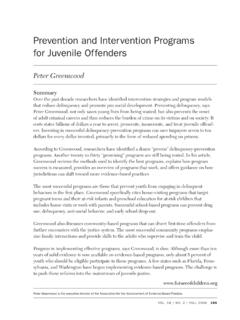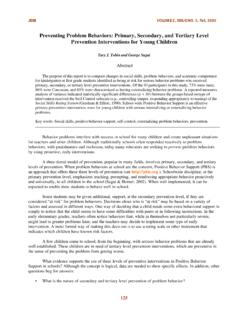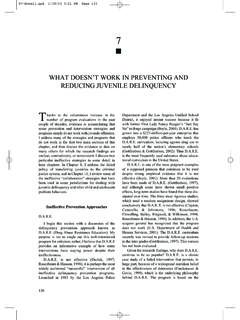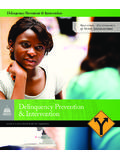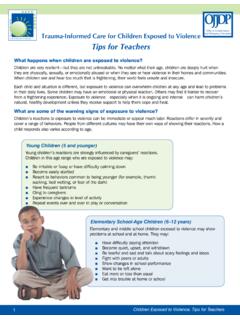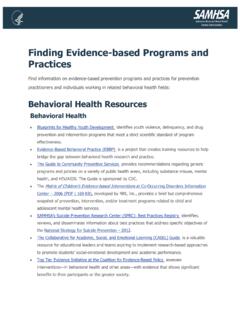Transcription of Treatment, Services, and Intervention Programs for Child ...
1 Bulletin Department of JusticeOffice of Justice ProgramsOffice of Juvenile Justice and delinquency Prevention Sparked by high-profile cases involvingchildren who commit violent crimes, pub-lic concerns regarding Child delinquentshave escalated. Compared with juvenileswhose delinquent behavior begins later inadolescence, Child delinquents (offendersyounger than age 13) face a greater riskof becoming serious, violent, and chronicjuvenile offenders. OJJDP formed theStudy Group on Very Young Offenders toexamine the prevalence and frequency of offending by children younger than Study Group identified particular riskand protective factors that are crucial todeveloping effective early interventionand protection Programs for very youngoffenders. This Bulletin is part of OJJDP s ChildDelinquency Series, which presents thefindings of the Study Group on Very YoungOffenders.
2 This series offers the latestinformation about Child delinquency , in-cluding analyses of Child delinquency sta-tistics, insights into the origins of veryyoung offending, and descriptions of earlyintervention Programs and approachesthat work to prevent the development ofdelinquent behavior by focusing on riskand protective with juveniles who startoffending in adolescence, Child delin-quents (age 12 and younger) are two to three times more likely to becometomorrow s serious and violent offend-ers. This propensity, however, can beminimized. These children are poten-tially identifiable either before theybegin committing crimes or at the veryearly stages of criminality times wheninterventions are most likely to suc-ceed. Therefore, treatment, Services, and Intervention Programs that targetthese very young offenders offer anexceptional opportunity to reduce theoverall level of crime in a much can be done to preventchild delinquency from escalating intochronic criminality, the most successfulinterventions to date have been isolat-ed and unintegrated with other ongoinginterventions.
3 In fact, only a few well-organized, integrated Programs designedto reduce Child delinquency exist inNorth America Study Group on Very Young Offend-ers (the Study Group), a group of 39experts on Child delinquency and childYouth who start offending early inchildhood age 12 or younger arefar more likely to become serious, vi-olent, and chronic offenders later inlife than are teenagers who begin tooffend during adolescence. We havean opportunity to direct these youngoffenders to a better path because re-search indicates that they are at anage when interventions are most like-ly to succeed in diverting them fromchronic of OJJDP s Child delinquency Se-ries, this Bulletin draws on findingsfrom OJJDP s Study Group on VeryYoung Offenders to assess Treatment, services, and Intervention programsdesigned for juvenile offenders underthe age of 13. The Bulletin reviewstreatment and services available tosuch Child delinquents and their fami-lies and examines their efficacy.
4 At atime of limited budgets, it is impera-tive that we consider the cost effec-tiveness of specific Programs becausechildren who are not diverted fromcriminal careers will require signifi-cant resources in the timely provision of the kindsof treatment, services, and interven-tion Programs described in thisBulletin while Child delinquents arestill young and impressionable mayprevent their progression to chroniccriminality, saving the expense oflater , Services, andIntervention Programs forChild Delinquents Barbara J. Burns, James C. Howell, Janet K. Wiig, Leena K. Augimeri,Brendan C. Welsh, Rolf Loeber, and David PetechukAccess OJJDP publications online at Robert Flores, AdministratorMarch 20032psychopathology convened by the Of-fice of Juvenile Justice and DelinquencyPrevention (OJJDP), has concluded thatjuveniles who commit serious and vio-lent offenses most often have shownpersistent disruptive behavior in earlychildhood and committed minor delin-quent acts when quite young.
5 There-fore, comprehensive interventionprograms should encompass childrenwho persistently behave in disruptiveways and Child delinquents, in additionto young juvenile offenders who havecommitted serious and violent on children who persistentlybehave disruptively and Child delin-quents has the following advantages: If early interventions are success-ful, both groups are less likely to be-come chronically delinquent if theyare exposed to additional risk fac-tors that typically emerge duringadolescence. If early interventions are successful,both groups are less likely to sufferfrom the many negative social andpersonal consequences of persistentmisbehavior. Both persistent disruptive behaviorand delinquency can be reducedat an early age through delinquents who become seriousand violent offenders consume signifi-cant funds and resources from the ju-venile justice system, schools, mentalhealth agencies, and other Child welfareand Child protection agencies.
6 Never-theless, many children, especially thosewho behave disruptively, are not receiv-ing the services they need to avoid livesmarked by serious delinquency andcriminal offending. More interventionprograms fostering cooperation amongfamilies, schools, and communitiesneed to be devised, implemented, Bulletin explores the services avail-able to children and their families andthe efficacy and cost effectiveness ofparticular interventions . (The StudyGroup s findings concerning risk factorsfor Child delinquency will be discussedmore fully in another Bulletin.) TheStudy Group reviewed how the mentalhealth, education, Child welfare, andjuvenile justice sectors meet the serviceneeds of children with conduct disorderor who exhibit conduct disorder not all children withconduct disorder are technically childdelinquents, the behavior and problemsof acting out associated with the disor-der are often delinquent in on children with conduct dis-order or who exhibit conduct disordersymptoms helps researchers targetboth children who commit delinquentacts but have not been detected andchildren at risk of committing such Bulletin also discusses juvenile jus-tice system Programs and strategies forvery young offenders.
7 Four promisingprograms the Michigan Early OffenderProgram, the Minnesota DelinquentsUnder 10 Program, the SacramentoCounty Community Intervention Pro-gram, and the Toronto Under 12 Out-reach Project that organize inter-ventions for Child delinquents arereviewed. In addition, the Bulletin out-lines a model for comprehensive inter-ventions and examines the Canadianapproach to Child delinquency , whichmay serve as a guide for preventionefforts in the United States and delinquency Research: An OverviewHistorically, delinquency studies have focused on later adolescence, the time whendelinquency usually peaks. This was particularly true in the 1990s, when most re-searchers studied chronic juvenile offenders because they committed a dispropor-tionately large amount of crime. Research conducted during this period by OJJDP sStudy Group on Serious and Violent Juvenile Offenders concluded that youthreferred to juvenile court for their first delinquent offense before age 13 are farmore likely to become chronic offenders than youth first referred to court at a laterage.
8 To better understand the implications of this finding, OJJDP convened theStudy Group on Very Young Offenders in 1998. Its charge was to analyze existingdata and to address key issues that had not previously been studied in the liter-ature. Consisting of 16 primary study group members and 23 coauthors who areexperts on Child delinquency and psychopathology, the Study Group found evi-dence that some young children engage in very serious antisocial behavior andthat, in some cases, this behavior foreshadows early delinquency . The Study Groupalso identified several important risk factors that, when combined, may be relatedto the onset of early offending. The Study Group report concluded with a review ofpreventive and remedial interventions relevant to Child Child delinquency Bulletin Series is drawn from the Study Group s final report,which was completed in 2001 under grant number 95 JD FX 0018 and subsequent-ly published by Sage Publications as Child Delinquents: Development, Intervention ,and Service Needs(edited by Rolf Loeber and David P.)
9 Farrington). OJJDP encour-ages parents, educators, and the juvenile justice community to use this informationto address the needs of young offenders by planning and implementing moreeffective to the Diagnostic and Statistical Manual ofMental Disorders IV (DSM IV) (American PsychiatricAssociation, 1994), conduct disorder symptoms in-clude aggression toward people and animals, destruc-tion of property, deceitfulness or theft, and seriousviolations of rules. Juveniles who exhibit conductdisorder symptoms are also prone to certain otherconditions, such as attention deficit/hyperactivitydisorder (ADHD), internalizing disorders (anxiety anddepression), and substance abuse (Angold, Costello,and Erkanli, 1999).3 Treatment ApproachesA growing body of research has focusedon the treatment of juvenile offendersand juveniles with conduct disorder. Anexamination of 200 studies publishedbetween 1950 and 1995 found that themost effective interventions for seriousand violent juvenile offenders wereinterpersonal skills training, individualcounseling, and behavioral Programs (Lipsey and Wilson, 1998).
10 Anotherreview of 82 studies of interventions forchildren and adolescents with conductproblems found strong evidence forseveral effective treatments, includingdelinquency prevention and parent- Child treatment Programs for preschool-age children and problem-solving skillstraining and anger-coping therapy forschool-age children (see, , Brestanand Eyberg, 1998).Examples of effective interventionsinclude the parent training programsbased on Patterson and Gullion s LivingWith Children(1968), which are designedto teach adults how to monitor childproblem and prosocial behaviors, rewardbehavior incompatible with problembehavior, and ignore or apply negativeconsequences to problem example of effective interven-tions is the parent-training programdeveloped by Webster-Stratton andHammond (1997), which involves groupsof parents in therapist-led discussions ofvideotaped less evidence of efficacy is availablefor psychopharmacology than psycho-social treatments; the results of studiesare often conflicting.










